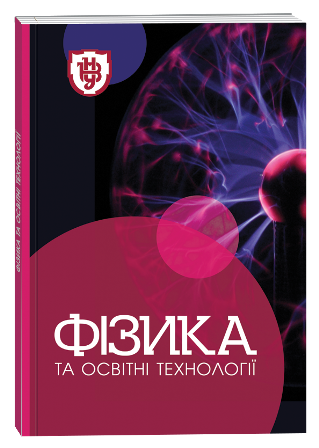PROPERTIES OF CHALCOGENIDE SEMICONDUCTORS OF GROUP AIBIIIC2 VI
DOI:
https://doi.org/10.32782/pet-2022-2-2Keywords:
core levels, activation energy, direct bandgap semiconductors, Urbach's ruleAbstract
It is shown that if one anion of diamond-like structures and structures derived from them has one octahedral and two tetrahedral voids, when cations must fill half of the tetrahedral voids, this means that six cations are required per Ag2In2SiSe6 formula unit to form a defect-free model. For Ag+ ions in the chalcopyrite structure, 25% of all voids (1/4 part) are allocated. In the Ag2In2SiSe6 structure, argentum fills 16.7% (1/6th) of the total number of tetrahedral voids. In the transition from AgInSe2 to Ag2In2SiSe6, indium is replaced by germanium, so the total number of filled (In, Si) Se4 tetrahedra per cell remains unchanged, and Argentum positions become defective. A comparison based on a single energy scale of the X-ray emission bands of Se Kβ2 and the X-ray photoelectron spectra of the valence band of crystals shows that a significant contribution to the upper part of the valence band is made by Se 4p states. The binding energies of core electrons of the constituent elements of non-irradiated and Ar+ ion-irradiated crystal surfaces were determined. We observe some sensitivity to their bombardment with Ar+ ions with an energy of 3.0 keV for 5 min. The content of indium atoms (In) in the layers increased by 1.4-1.5 times, selenium atoms (Se) did not change. The effective mass of electrons and holes was estimated using the DFT/PBE potential for various structures in two mutually perpendicular directions. The ratio of the calculated effective mass of electrons to the free electron is 0.1449. The band gap at different temperatures was evaluated, the values Eg for the compound Ag2In2SiSe6 are 1.76 eV (100K) and 1.68 eV (300K). The work established that Ag2In2SiSe6 6 crystals are direct-band semiconductors. The fulfillment of Urbach's rule and its great significance proves that the crystals belong to defective semiconductors, which in terms of their electronic structure are close to disordered systems.
References
O. Y. Khyzhun, Y. V. Zaulychny, E. A. Zhurakovsky Electronic Structure of Tungsten and Molybdenum Germanides Synthesized at High Pressures J. Alloys Compd. 1996. Vol. 244, № 1–2. P. 107–112.
V. B. Lazarev, Z. Z. Kish, E. Yu. Peresh, E. E. Semrad. Complex Chalcogenides in AI–BIII–CVI Systems Moscow : Metallurgiya. 1993. 240 p.
I. D. Olekseyuk, A. V. Gulyak, L. V. Sysa [et al.] Crystal Chemical Properties and Preparation of Single Crystals of AgGaSe2–GeSe2 γ-solid Solutions J. Alloys Compd. 1996. Vol. 241. № 1–2. P. 187–190.
V. V. Halyan, M. V. Shevchuk, G. Ye. Davydyuk [et al.] Glass formation region and X-ray analysis of the glassy alloys in AgGaSe2+GeS2⇔AgGaS2+GeSe2 system Semicond. Phys. Quantum Electron. Optoelectron. 2009. Vol. 12, № 2. P. 138–142.
V. V. Badikov, A. G. Tyulyupa, G. S. Shevyrdyaeva, S. G. Sheina Solid Solu in the AgGaS2–GeS2 and AgGaSe2–GeSe2 System Inorg. Mater. 1991. Vol. 27, № 2. P. 177–180.
Y. Zhang, X. Sun, P. Zhang [et al.] Structural Properties and Quasiparticle Band Structures of Cu-based Quaternary Semiconductors for Photovoltaic Applications J. Appl. Phys. 2012. Vol. 111, № 6. P. 063709-6.
M. Makowska-Janusik, I. V. Kityk, G. Myronchuk [et al.] Manifestation of Intrinsic Defects in the Band Structures of Quaternary Chalcogenide Ag2In2SiSe6 and Ag2In2GeSe6 Crystals Cryst. Eng. Commun. 2014. Vol. 16, № 40. P. 9534–9544.
O. Y. Khyzhun, G. L. Myronchuk, O. V. Zamurueva, O. V. Parasyuk Electronic Structure and Photoelectrical Properties of Ag2In2SiSe6 and Ag2In2GeSe6 Opt. Mater. 2014. Vol. 38. P. 10–16.
S. Hüfner, Photoelectron Spectroscopy: Principles and Applications, Springer Science & Business Media, 2013.
Yu. Andreev, P. Geiko, V. Voevodin, A. Gusamov Optical Properties of AgGaxIn1-xSe2 Crystals Jpn. J. Appl. Phys. 2000. Vol. 39, № S1. P. 94–95.
Urbach F. The Long-Wavelength Edge of Photographic Sensitivity and of the Electronic Absorption of Soils Phys. Rev. 1953. Vol. 92, № 5. P. 1324.
A. Meisel, G. Leonhardt, R. Szargan, X-Ray Spectra and Chemical Binding New York: Springer-Verlag, 1989.








